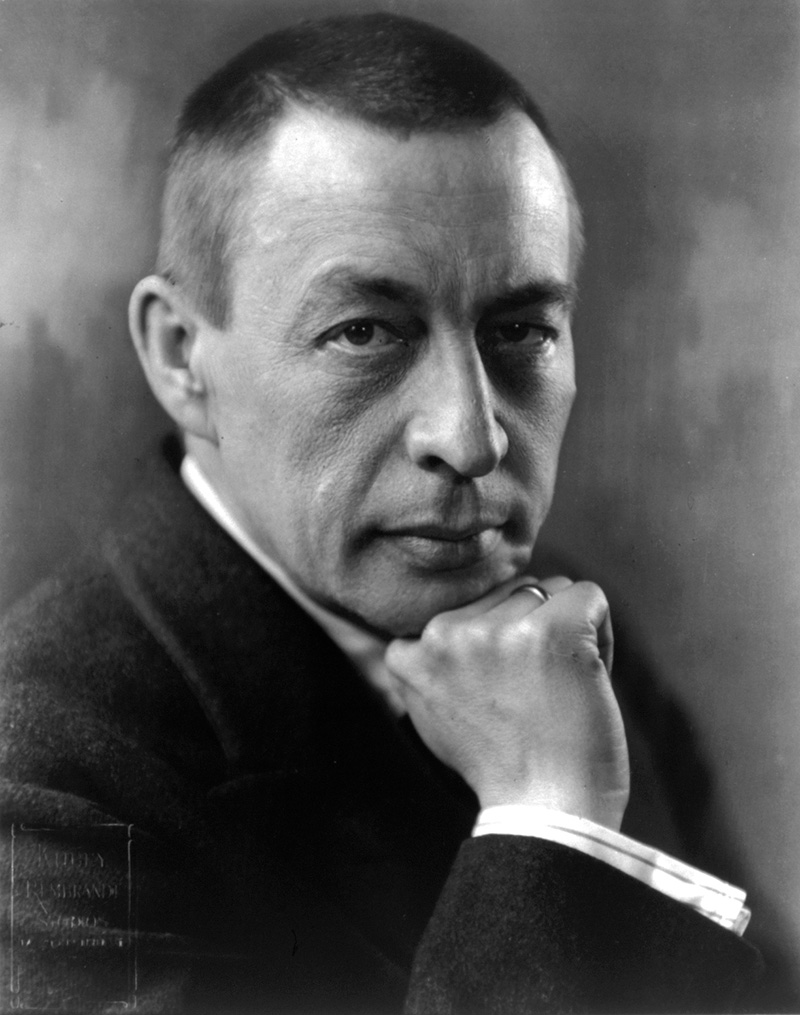Sergei Rachmaninoff

- Born: April 1, 1873, Oneg (near Novgorod), Russia
- Died: March 28, 1943, Beverly Hills, California
Concerto No. 2 in C Minor for Piano and Orchestra, Op. 18
- Composed: 1900–01
- Premiere: October 14, 1901 in Moscow, Alexander Siloti conducting; Sergei Rachmaninoff, piano
- Instrumentation: solo piano, 2 flutes, 2 oboes, 2 clarinets, 2 bassoons, 4 horns, 2 trumpets, 3 trombones, tuba, timpani, bass drum, crash cymbals, strings
- Duration: approx. 35 minutes
Drawing Success Out of Failure
When he was old and as mellow as he would ever get, Rachmaninoff wrote these words about his early years: “Although I had to fight for recognition, as most younger men must, although I have experienced all the troubles and sorrow which precede success, and although I know how important it is for an artist to be spared such troubles, I realize, when I look back on my early life, that it was enjoyable, in spite of all its vexations and bitterness.” The greatest “bitterness” of Rachmaninoff’s career was the total failure of the Symphony No. 1 at its premiere in 1897, a traumatic disappointment that thrust him into such a mental depression that he suffered a complete nervous collapse.
An aunt of Rachmaninoff, Varvara Satina, had recently been successfully treated for an emotional disturbance by a certain Dr. Nicholas Dahl, a Moscow physician who was familiar with the latest psychiatric discoveries in France and Vienna, and it was arranged that Rachmaninoff should visit him. Years later, in his memoirs, the composer recalled the malady and the treatment:
[Following the performance of the First Symphony,] something within me snapped. A paralyzing apathy possessed me. I did nothing at all and found no pleasure in anything. Half my days were spent on a couch sighing over my ruined life. My only occupation consisted in giving a few piano lessons to keep myself alive.
For more than a year, Rachmaninoff’s condition persisted. He began his daily visits to Dr. Dahl in January 1900.
My relatives had informed Dr. Dahl that he must by all means cure me of my apathetic condition and bring about such results that I would again be able to compose. Dahl had inquired what kind of composition was desired of me, and he was informed “a concerto for pianoforte.” In consequence, I heard repeated, day after day, the same hypnotic formula, as I lay half somnolent in an armchair in Dr. Dahl’s consulting room: “You will start to compose a concerto—You will work with the greatest of ease—The composition will be of excellent quality.” Always it was the same, without interruption.... Although it may seem impossible to believe, this treatment really helped me. I started to compose again at the beginning of the summer.”
In gratitude, he dedicated the new Concerto to Dr. Dahl.
Dazzling Virtuosity
The C Minor Concerto begins with eight bell-tone chords from the solo piano that herald the surging main theme, announced by the strings. A climax is achieved before a sudden drop in intensity makes way for the arching second theme, initiated by the soloist. The development, concerned largely with the first theme, is propelled by a martial rhythm that continues with undiminished energy into the recapitulation. The second theme returns in the horn before the martial mood is re-established to close the movement. The Adagio is a long-limbed nocturne with a running commentary of sweeping figurations from the piano. The finale resumes the marching rhythmic motion of the first movement with its introduction and bold main theme. Standing in bold relief to this vigorous music is the lyrical second theme, one of the best-loved melodies in the entire orchestral literature, a grand inspiration in the ripest Romantic tradition. (Years ago, this melody was lifted from the Concerto by the tunesmiths of Tin Pan Alley and fitted with sufficiently maudlin phrases to become the popular hit “Full Moon and Empty Arms.”) These two themes, the martial and the romantic, alternate for the remainder of the movement. The coda rises through a finely crafted line of mounting tension to bring the work to an electrifying close.
—Dr. Richard E. Rodda